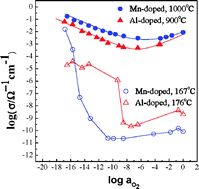Electrical conductivity–defect structure correlation of variable-valence and fixed-valence acceptor-doped BaTiO3 in quenched state
Abstract
Insulation resistance degradation of dielectric BaTiO3 is expected to be closely correlated to its defect structure frozen in from elevated processing temperatures. For BaTiO3, respectively doped with variable-valence (MnTi) and fixed-valence acceptors (AlTi), their defect structures were frozen in by quenching at different equilibrium oxygen activities in the range of −18 < log aO2≤ 0 at 1000 and 900 °C, respectively, and their electrical conductivities were measured against temperature in the range of 200 ≤T/K ≤ 494 by

- This article is part of the themed collection: Physical chemistry of solids - The science behind materials engineering

 Please wait while we load your content...
Please wait while we load your content...